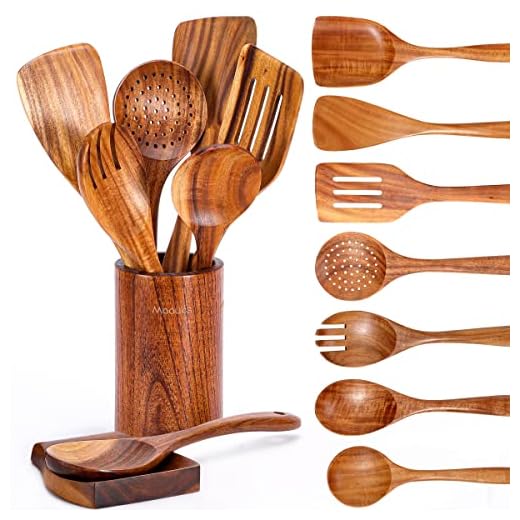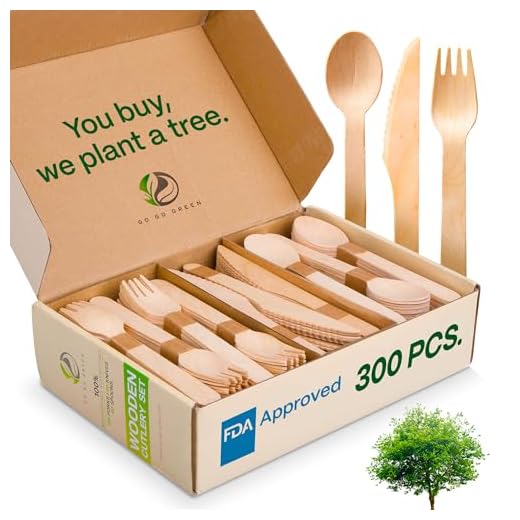
Why Switch to Plant Utensils?
You see plastic every day. It litters streets and oceans. It shreds into tiny bits. Those bits travel far. They reach your plate. You can choose better. Plant utensils are made from plants, not oil. They cut waste. They feel like real tools. They work well.
Switching helps you and the earth. You lower plastic pollution. You avoid microplastics in food. You pick durable, compostable tools. This guide shows what to look for. It helps you choose, use, and care for plant-based utensil sets with confidence. You act by buying smart. Your small choice matters. It saves future waste now.
Essential Plant-Based Kitchen Tools: Quick Guide to Cooking Like a Pro
What Plant Utensil Sets Are and How They Work
What they are
You buy a set for your hands. You choose sporks, knives, forks, spoons, chopsticks, and carry pouches. Some sets add a straw or a pair of tongs. They look like plastic. They feel like tools. They come as single pieces or nested kits for travel.
Common set types
Common materials
Makers use corn, bamboo, wheat straw, bagasse (sugarcane fiber), and wood. Each acts different. Corn often blends with a binder. Bamboo comes as solid strips or laminated sticks. Wheat straw and bagasse are pressed into shape. Wood stays wood.
How they are made
Producers grind fibers. They add heat and pressure. They add binders. Binders can be plant starches, bio-resins, or PLA (a corn-based plastic). Sometimes they mold with high pressure and heat. Solid wood and bamboo are carved and sanded. The craft matters. Thin walls or poor presses weaken tools.
How they behave
Plant utensils work well for cool and warm foods. Some hold up in hot liquids. Some will soften in heat or grease. Oils can darken fibers. Acidic foods may sting the finish. Expect a mix: a bamboo fork will stay firm for curry. A low-grade corn knife may bend in hot soup. Real use tests tell the truth.
Quick checklist to judge a set
Next, you will learn how sourcing and material choices change performance and end-of-life.
Materials and Sourcing: Know What You Use
Read the label
You must read labels. Look for percent plant content. Look for the binder name. Look for compostability claims. If it is vague, ask. Vague means greenwash.
Material snapshots
PLA (polylactic acid). A corn-based bioplastic. Smooth. Rigid. Often needs industrial composting. Melts in very hot liquids.
Bagasse. The fibrous part of sugarcane left after juice. Rough, dense, heat-resistant. Often industrially compostable. Good for hot food.
Wheat straw. Light, slightly grainy feel. Made from stalks after harvest. Uses waste, so low food-competition.
Wheat- or corn-based blends. Vary in strength. Watch for added petro binders.
Bamboo and wood. Solid feel. Durable if untreated. Can be polished or coated. Source matters for forests and farms.
Food crops vs waste streams
Ask whether the feedstock competed with food. Corn for PLA comes from a food crop. Bagasse and wheat straw come from waste. Bamboo grows fast and is not a staple food. Prefer waste streams or fast-regrowth crops.
Sourcing and certification
Look for clear marks: BPI, ASTM D6400, EN 13432, FSC for wood, or USDA BioPreferred. Check the fine print. Industrial-compostable is not the same as home-compostable.
Spot greenwash
Claims like “eco,” “green,” or “bioplastic” mean little alone. No proof equals no trust. Beware of pictures of leaves without certificates. Small fonts hide limits.
Questions to ask sellers
Next you will test these materials in real life. You will learn which ones bend, which ones break, and which ones stay loyal.
Durability and Performance: Real Use Tests
What we look for
You want tools that work. You want them to stir, scoop, cut, and scrape without folding or flaking. We test strength, heat hold, and stain fight. We watch how pieces bend, then break. We use short, real tasks you will do.
Strength and flex
Bamboo and hard wood stand firm. Bagasse and wheat straw are stiff but can snap under twist. PLA feels rigid. Silicone bends and springs back. Try this: press the tip of a fork hard against a bowl rim. If it flexes more than a finger’s width, it will limp on heavy foods.
Heat and stain resistance
Hot soup can soften PLA. Bamboo and bagasse resist heat to about typical serving temps. Silicone mates best with hot pans. Stains stick less to smooth surfaces. Dark sauces will tint porous wood.
Everyday task trials
Flex and break tests you can run
Travel and match-to-need
For camping pick hard wood or robust bagasse. For office lunch, thin reusable PLA sets are light and tidy. For picnics, mix a silicone scraper with a bamboo fork. For daily dishes, choose what survives the twist test.
Next you will learn how to care for these pieces, and how to compost them when they finally reach their end of life.
Health and Safety: What to Watch For
Lab seals — plain meaning
You eat with these tools. Read labels. Here is what common seals mean:
Heat limits and leaching risks
Heat changes things. PLA and some bioplastics soften near hot soup temps. Wood can char. Silicone holds heat well. If a piece warps or smells when heated, stop using it for hot food. Never microwave utensils unless they say microwave-safe.
Quick checks you can do at home:
Coatings and additives to avoid
Watch glossy finishes. They can flake. Painted or printed logos may chip into food. Ask the seller about finishes and adhesives. Prefer oil-finished wood over lacquered wood for eating surfaces. Prefer plain, uncoated bagasse or bamboo if you want low risk.
When to stop using a set
Stop at the first sign of failure. Look for:
Inspect often. Replace pieces that fail any test. Your food deserves clean tools.
Buying Guide: Choose the Right Plant Utensil Set for You
Core factors to weigh
Match a set to your life
Pick one that fits one routine. Small trade-offs change daily use.
Commuters checklist:
Parents checklist:
Office workers checklist:
Campers checklist:
Shopping tips and labels
Ask the seller: where is it made? What is the heat limit? Are finishes food-safe? Look for EN 13432 or ASTM D6400 for compostable claims. “Food-safe” and “BPA-free” matter. “Home-compostable” is rare; check tests.
Compare value, not price. Divide cost by expected uses. A $20 set that lasts 2 years can beat a $5 set that warps in weeks. Read reviews for long-term wear and for customer service that replaces broken parts.
Next, you’ll learn how to care for your set and how to return it to the earth.
Care, Composting, and End-of-Life
Daily care: wash and dry
Wash soon after use. Rinse food off. Use warm water and mild soap. Scrub wooden or fiber pieces with a soft brush. Do not soak bamboo or bagasse for hours. Dry upright. Open the case so air moves. A damp case breeds mold.
Dishwasher and heat
Know your set’s limits. Stainless and silicone survive dishwashers and high heat. Plant fibers, bagasse, wheat-straw, and many bamboo sets usually do not. PLA softens above ~60°C (140°F). When in doubt, hand wash. Test one piece first if the label is unclear.
Composting routes: home vs industrial
Home compost accepts plain wood, untreated bamboo, and many bagasse pieces. It takes weeks to months. Industrial composting handles PLA and certified “compostable” plastics. Look for ASTM D6400 or EN 13432 on the label. If an item says “compostable” but not certified, check the vendor. PLA tossed in home compost may sit there for years.
When a set fails: cut down on waste
Repair small breaks with food-safe glue or replace one piece if the brand sells spares. Keep a kit of spare forks and spoons. Buy modular sets so you can swap one broken item instead of tossing the whole kit.
Repurpose, donate, or recycle
Turn old spoons into plant labels. Use a broken knife as a pot-scraper. Donate lightly used sets to shelters, food pantries, schools, or community kitchens. Recycle metal in scrap metal bins. Send silicone to specialty recyclers if curbside won’t take it.
Close the loop: simple steps
Remove non-compostable parts. Check local compost rules. Label the compost bin for tools and staff. Buy with end-of-life in mind next time. Ready for a final push? The Conclusion will show how to make the switch and keep it simple.
Make the Switch and Keep It Simple
You can act now. Plant utensils cut waste and feel solid. Buy one good set. Use it daily. Test it at home. Check for heat and stain resistance. Look for clear materials and honest sourcing. Prefer biodegradable or well-made fiber blends.
Care for them. Wash by hand or on gentle cycle. Dry fully. Repair when you can. When worn, compost or recycle per label. Teach your friends. Bring them to meals and work. Small acts grow. Keep it simple. Keep it steady. Start small. Buy one set. Use it. Show others the way.















Minor rant: I got a ‘compostable’ set once and they turned into mush in hot soup. Why isn’t durability standardized? The ‘Durability and Performance’ tests in this article were helpful but felt limited.
Question: if a product is listed as ‘plant-based’ does it always mean it’s renewable? Or are there hidden chemicals? Want to make sure I’m not being greenwashed.
I like the ‘Make the Switch and Keep It Simple’ vibe. Small switches like carrying a travel stainless set to lunch made me feel less guilty about takeout. Plus, the case for the travel set fits in my purse which is clutch.